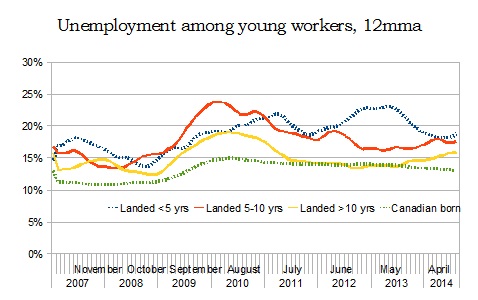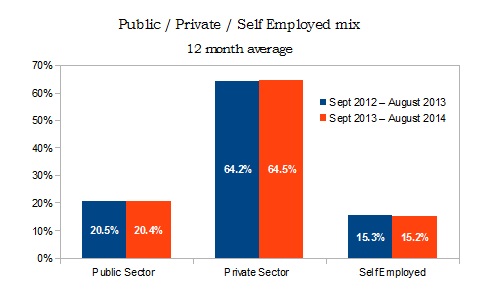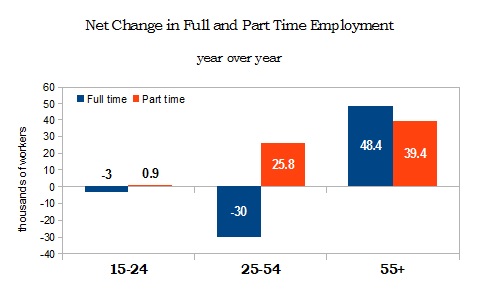Last week Statistics Canada released their first set of job numbers since the “oops” of July 2014. And the news was dismal. The labour market shed 112,000 private sector positions, the largest single-month drop in the private sector since, well, forever. Coming on the heels of a mistake is unfortunate, but you have to think that Statistics Canada was extra vigilant this month and checked everything up, down, backwards, and sideways.
Either way, month-to-month variations are far less meaningful than overall trends, so let’s have a look at those, shall we?
Part-time work
Only workers over 55 have seen an increase in full-time work compared to last August, and most of this is likely due to demographic change. Among core-age workers there were fewer full-time jobs and more part-time jobs. Young workers traded 3,000 full-time jobs for less than a thousand part-time ones.
Temporary work
The picture is quite similar for temporary employment. Year over year, core-age workers saw a drop in the number of permanent jobs, and an increase in temporary employment.

Young workers
Young workers in particular have difficulty finding work when the labour market is slack. As do new Canadians. So it would follow that young workers who are also new Canadians have an even harder time. The graph below shows the unemployment rate for young workers as a 12-month moving average from January 2007.
At its peak, the unemployment rate for young workers who had been landed immigrants for 5 -10 years almost hit 25 per cent. While the unemployment rate for Canadian born young workers remains elevated over its pre-recession level, the trend seems to be gradually falling. On the other hand, the unemployment rate is rising for all three categories of new Canadian young workers.

Source: CANSIM 282-0103
Public-private mix
Such a huge drop in private sector employment is a concern, since the labour market has been very heavily relying on private sector gains for the minimal job growth we have seen this year. And the huge spike in self-employment is also worrisome, as these jobs are more often precarious ones.
The good news is that this month’s drop in private-sector employment and spike in self-employment didn’t really change the overall mix when you look at the average over the past 12 months and compare this to the year before.

Source: CANSIM 282-0011
With far too few job vacancies, and record low proportions of unemployed workers receiving EI (especially in urban areas), the Canadian labour market is looking pretty depressing. I think there’s going to be a lot to discuss at Unifor’s upcoming Good Jobs Summit in Toronto.




